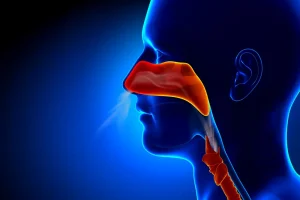What is nasal congestion?
Nasal congestion, commonly known as a “stuffy nose,” is a discomfort caused by swelling of the nasal mucosa and excessive mucus buildup. It occurs when the nasal tissues become inflamed and the blood vessels dilate, narrowing the airways and making breathing difficult.
Usually, congestion clears up within a few days, but if it persists for more than a week, it may indicate an infection such as sinusitis. When left untreated, it can lead to complications like nasal polyps or middle ear infections.
In most cases, a stuffy nose is a symptom of another condition, such as a cold, allergic rhinitis, or a sinus infection.
How does nasal congestion manifest?
Nasal congestion is not just an isolated inconvenience — it is often accompanied by other symptoms that vary depending on the underlying cause. The most common include:
- Difficulty breathing through the nose
It feels as if air can no longer pass normally through the nostrils. This is caused by inflammation of the nasal mucosa and mucus buildup that narrows the airways. - Nasal discharge (rhinorrhea)
It may be clear and watery in allergies or colds, or thick and yellow-green in bacterial infections. Mucus is a natural defense mechanism against irritants and pathogens. - Frequent sneezing
A reflex triggered to expel irritant particles, often seen in allergies or exposure to dust, pollen, smoke, or perfumes. - Facial pressure or pain
Felt around the forehead, cheeks, eyes, or between the eyebrows. It results from blocked sinuses and mucus buildup, increasing pressure in the sinus cavities. - Headache
Often a dull pain worsened by head movement, caused by sinus inflammation or tension from severe congestion. - Reduced or lost sense of smell and taste
Blocked nasal passages prevent odor molecules from reaching olfactory receptors, which also affects taste perception. - Mouth breathing
Becomes more common when nasal breathing is difficult, leading to dry mouth and throat irritation. - Dry throat sensation
Caused by prolonged mouth breathing. Air is no longer filtered and humidified properly, irritating the throat lining.
What causes nasal congestion?
Nasal congestion is most often the result of mild conditions like colds, flu, or sinus infections. In such cases, symptoms usually improve within 7–14 days. When congestion lasts longer than two weeks, it may signal a chronic condition or structural or immune imbalance.
The most common causes include:
- Respiratory allergies
Conditions such as seasonal allergic rhinitis (hay fever) or perennial allergies (to dust, pet dander, or mold) cause persistent inflammation of the nasal lining. - Nasal polyps
Benign growths inside the nasal cavities that can block normal airflow. - Sinonasal tumors
Rare, but possible in advanced or undiagnosed cases. - Chronic sinusitis
Long-term sinus infections cause ongoing inflammation and mucus accumulation. - Deviated septum or other anatomical abnormalities
A deviated septum or enlarged turbinates can obstruct airflow. - Enlarged adenoids
More common in children and may contribute to nasal blockage. - Gastroesophageal reflux disease (GERD)
In infants, reflux can irritate the upper airways and cause congestion. - Exposure to irritants
Toxic vapors, pollutants, or cigarette smoke can inflame the nasal mucosa.
Nasal congestion during pregnancy
During pregnancy, especially from the second trimester, hormonal changes and increased blood flow may cause swelling of the nasal mucosa. This physiological congestion is common and usually temporary.
Rhinosinusitis – a common cause of congestion
When both the nasal mucosa and sinuses become inflamed, it’s called rhinosinusitis, which can take several forms:
- Infectious – caused by viruses or bacteria;
- Allergic – triggered by environmental allergens;
- Seasonal – occurring in spring or autumn when pollen levels are high;
- Perennial – related to constant allergens (dust mites, mold, etc.);
- Non-allergic – caused by irritants like smoke, perfumes, or chemicals.
Other less common causes
- Weakened immune system
People with compromised immunity (HIV, diabetes, chemotherapy) are more vulnerable to respiratory infections that cause congestion. - Body position
Individuals who are bedridden or lie down frequently may experience reduced nasal drainage, leading to mucus buildup. - Mucociliary clearance disorders
In certain genetic diseases, such as cystic fibrosis, or rare conditions like biliary dyskinesia, mucus transport is impaired, increasing the risk of persistent congestion.
How is nasal congestion diagnosed?
To identify the exact cause, your doctor will begin with a discussion about your symptoms and perform a physical examination of the nose, ears, and throat. Depending on the case, further tests may be needed, such as:
- Throat swab (culture)
Used to detect bacterial infections, especially streptococcal. - CT scan (Computed Tomography)
Provides detailed images of the nasal and sinus structures to detect blockages or anatomical issues. - Nasal endoscopy
A minimally invasive procedure using a thin tube with a camera to closely examine the nasal passages and sinuses.
Treatment options for nasal congestion
Treatment depends on the underlying cause, but in most cases, a combination of medication and home care can relieve symptoms. Common approaches include:
- Over-the-counter medications (OTC)
- Nasal decongestants: reduce mucosal swelling and ease breathing. Available as sprays (oxymetazoline, naphazoline, phenylephrine) or oral tablets (pseudoephedrine). Use only short-term to prevent rebound congestion.
- Antihistamines: effective when congestion is allergy-related. They reduce allergic reactions and nasal secretions. Some may cause drowsiness.
- Corticosteroid nasal sprays: help with persistent inflammation, especially in chronic rhinosinusitis or allergies. Effects develop gradually after several days of consistent use.
- Menthol or camphor products: available as ointments or inhaled vapors, they help clear the nose and provide a cooling sensation.
- Pain relievers: medications such as paracetamol or ibuprofen can ease headaches and facial pressure caused by sinus inflammation.
Consultant: Dr. Iuliu Cătană
Frequently Asked Questions
How can I treat a stuffy nose at home?
In addition to medication, some simple home remedies can help reduce symptoms and make breathing easier:
Using a humidifier – Helps keep the air moist and prevents the nasal passages from drying out.
Inhaling steam – Either from hot showers or from hot water containers. Steam can help loosen mucus.
Staying hydrated – Drinking plenty of fluids helps thin mucus.
Saline nasal sprays – Helps clear nasal passages and reduce inflammation.
Can allergens cause constant nasal congestion?
Yes. Constant exposure to allergens such as dust mites, animal dander, or pollen can lead to persistent congestion, especially in perennial or seasonal allergic rhinitis.
Is it dangerous to use decongestant sprays too often?
Yes. Long-term use (more than 3–5 days) can lead to a “rebound effect” – congestion returning or getting worse once treatment is stopped.
Can nasal congestion affect sleep?
Absolutely. A stuffy nose can lead to mouth breathing, snoring, shallow sleep, and even apnea in some cases.
Is it normal for babies to have stuffy noses?
Yes, especially in the first few months of life. Congestion can be caused by a dry environment, reflux, or viral infections. However, if it persists or affects feeding, you should consult your pediatrician.











